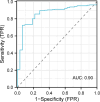Prediction of calcium oxalate kidney stones: A comprehensive analysis of clinical and gut microbiome characteristics
- PMID: 40696591
- PMCID: PMC12282706
- DOI: 10.1097/MD.0000000000043103
Prediction of calcium oxalate kidney stones: A comprehensive analysis of clinical and gut microbiome characteristics
Abstract
In recent years, the role of the gut microbiome in stone formation has gained increasing attention. Specifically, certain gut microbes that metabolize oxalate may regulate oxalate levels in the body, thereby influencing the occurrence of kidney stones. This study aims to investigate the clinical characteristics of calcium oxalate stone patients, the composition of their gut microbiome, and the relationship between these factors and stone formation. This study included 159 calcium oxalate stone patients (case group) and 141 healthy controls (control group). Clinical data were collected to analyze differences in body mass index, urinary metabolic markers (urinary oxalate, calcium, and pH), and other indicators between the 2 groups. High-throughput 16S rRNA sequencing was used to compare the diversity and composition of the gut microbiome. Further, correlations between the gut microbiome and clinical metabolic indicators were analyzed, and a risk prediction model for calcium oxalate stones was developed based on clinical and gut microbiome characteristics. Significant differences in body mass index, urinary oxalate concentration, urinary calcium concentration, and urinary pH were observed between the case and control groups. Gut microbiome diversity analysis revealed that the Shannon and Chao1 indices were lower in the case group, and significant differences in microbiome composition were found. The abundance of Proteobacteria and Firmicutes changed significantly, with a notable decrease in Oxalobacter formigenes and an increase in Escherichia-Shigella species in the case group. Correlation analysis showed a negative correlation between O formigenes abundance and urinary oxalate concentration, and a negative correlation between Escherichia-Shigella and urinary pH. The random forest prediction model exhibited high predictive accuracy (area under the receiver operating characteristic curve = 0.90). The formation of calcium oxalate stones is closely related to the structure and function of the gut microbiome, particularly with the reduced abundance of the oxalate-degrading bacterium O formigenes. Gut microbiome imbalance may influence stone formation through various mechanisms. This study provides new theoretical insights for the early prediction, prevention, and treatment of calcium oxalate stones.
Keywords: calcium oxalate stones; gut microbiome; prediction model; urinary metabolism.
Copyright © 2025 the Author(s). Published by Wolters Kluwer Health, Inc.
Conflict of interest statement
The authors have no funding and conflicts of interest to disclose.
Figures
References
MeSH terms
Substances
LinkOut - more resources
Full Text Sources




